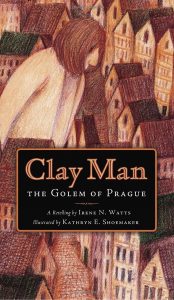 It is 1595, and the rabbi’s son Jacob is frustrated with having to live in the walled ghetto known as Jewish Town. Why can’t he venture outside of the gates and explore the beautiful city? His father warns him that Passover is a dangerous time to be a Jew and that the people from outside accuse the Jews of dreadful deeds. But one night, Jacob follows his father and two companions as they unlock the ghetto gates and proceed to the river, where they mold a human shape from the mud of the riverbank. When the rabbi speaks strange words, the shape is infused with life and the Golem of Prague is born.In this breathtaking retelling of a timeless tale, Irene N. Watts’s beautiful words are complemented by the haunting black-and-white images of artist Kathryn E. Shoemaker.
It is 1595, and the rabbi’s son Jacob is frustrated with having to live in the walled ghetto known as Jewish Town. Why can’t he venture outside of the gates and explore the beautiful city? His father warns him that Passover is a dangerous time to be a Jew and that the people from outside accuse the Jews of dreadful deeds. But one night, Jacob follows his father and two companions as they unlock the ghetto gates and proceed to the river, where they mold a human shape from the mud of the riverbank. When the rabbi speaks strange words, the shape is infused with life and the Golem of Prague is born.In this breathtaking retelling of a timeless tale, Irene N. Watts’s beautiful words are complemented by the haunting black-and-white images of artist Kathryn E. Shoemaker.
Jewish
Strange Relations
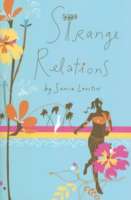
A summer in paradise. That’s all Marne wants. That’s all she can think of when she asks her parents permission to spend the summer in Hawaii with Aunt Carole and her family.
But Marne quickly realizes her visit isn’t going to be just about learning to surf and morning runs along the beach, despite the cute surfer boy she keeps bumping into. For one thing, Aunt Carole isn’t even Aunt Carole anymore—she’s Aunt Chaya, married to a Chasidic rabbi and deeply rooted in her religious community. Nothing could be more foreign to Marne, and fitting into this new culture—and house full of kids—is a challenge. But as she settles into her newfound family’s daily routine, she begins to think about spirituality, identity, and finding a place in the world in a way she never has before.
This rich novel is a window into a different life and gets to the very heart of faith, identity, and family ties.
Built by Angels
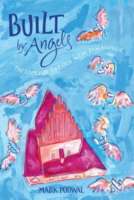
As legend tells it, the Old-New Synagogue in Prague was built by angels, and later was home to a golem who remains locked away in the building to this day. In lyrical prose, Mark Podwal shares the story of the world’s oldest active synagogue, which was completed in 1270. Throughout the years, this sacred place of prayer and celebration has endured plagues, wars, and the Nazi regime. Its story is part legend, part history, and one that stands as a testament to the perseverance of the Jewish people.
Guttersnipe
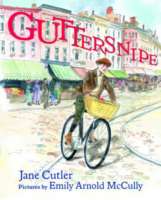
Early in the twentieth century, ten-year-old Ben and his family live in the poorest part of their city with other Jewish immigrants. There is never enough money to make ends meet, so Ben, determined to do his part, lands a job delivering hat linings to a hat factory after school. He sets out on his boss’s bicycle feeling strong and free, and has a grand time until, on his way up Hill Street, he gets a harsh comeuppance, one that hurts his body and threatens to destroy his dreams as well. Based on the experiences of the author’s father and illustrated in Emily Arnold McCully’s signature style, this book celebrates a boy who nearly loses hope, but then learns that the future shines bright and full of second chances.
The Passersby (Edge Books)
The War Within
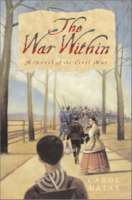
Holly Springs, Mississippi, 1862: The Green family owns a general store in this small Southern town where they have lived for many years. But ever since the Union army occupied her beloved town, Hannah Green has been furious. Her sister, Joanna, has fallen in love with Captain Mazer of the Union — the same Union that has been fighting against her brothers in the Confederate army to destroy the Southern way of life. Now General Grant has issued General Order #11, which commands all Jews to evacuate the territory under his command. The Greens are forced to follow the Union army to Memphis. For the first time Hannah and her family face discrimination simply because of their religion. She begins to realize that not everyone believes the basic truths she has always accepted. While the battles rage around her, Hannah begins to fight another war — the war within — which could destroy everything she has ever believed. With the historical accuracy for which she is known, best-selling author Carol Matas turns her attention to an unexamined chapter of the Civil War and creates a thought-provoking and heart-racing masterpiece.
The Fighter
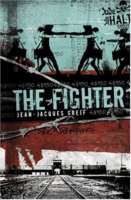
Fighting is a way of life for Moshe Wisniak. As a boy from a very poor neighborhood in Warsaw, he can’t run away when Polish kids attack the Jews, because his legs are weak. So he learns to use his fists, his head and other weapons to defend himself and his brothers. When the family moves to Paris in 1929, everyone finds work and life improves slowly. Moshe, now Maurice, is a leather worker and a young husband. At a Jewish sports club, he takes up boxing, and becomes an amateur flyweight. But the war comes to Paris, and by 1942, the French police round up foreign Jews and the Germans deport them by the hundreds every day. They send Maurice to the death camp at Auschwitz. In the camp, SS officers sense Maurice’s strength. They command him to box against a dying prisoner. Now Maurice is faced with an impossible moral dilemma: kill the prisoner or be killed by the SS for refusing to obey them. Translated from French by award-winning author Jean-Jacques Greif, The Fighter isn’t simply another book about the Holocaust. It is a book about a hero who discovers the death-defying power of his own humanity.
Take a closer look at The Fighter as examined in WOW Review.
The Anne Frank Case: Simon Wiesenthal’s Search For The Truth
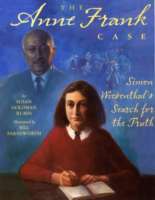
Determined to find definitive proof that Anne Frank’s diary was authentic, Simon Wiesenthal began a five-year-long search for the Gestapo officer who arrested the Frank family. This inspiring and suspenseful account testifies to the difference that one person’s dedication can make.
The Secret Of Priest’s Grotto: A Holocaust Survival Story (Holocaust)

According to legend, a group of Jewish families survived the Holocaust by hiding out for months in the 77 miles of caves in Ukraine known as Priest’s Grotto. Cavers Taylor and Nicola chronicle their trip to explore the caves and uncover the story of the survivors.
Love Every Leaf: The Life of Landscape Architect Cornelia Hahn Oberlander
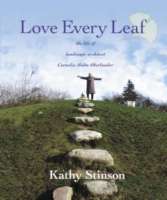
Cornelia Hahn Oberlander, who has been a landscape architect for more than sixty years, considers her profession “the art of the possible.” The description also applies to the very way this remarkable 86-year-old has lived her life. Playing in her grandmother’s garden as a child, Cornelia absorbed the beauty and importance of the natural world and by the age of eleven had decided that she would become a landscape architect.Leaving her native Germany in the wake of Hitler’s persecution of the Jews, the teenaged Cornelia was transplanted in America, where she could pursue her dream in safety, although not without having to struggle to carve out a place for herself in the male-dominated world of her chosen profession.
This 96-page biography tells her remarkable life’s story, complete with photographs and plans for the imaginative playgrounds and the innovative museum and embassy grounds she has created around the world, and for green rooftops, her latest passion. Young readers will not only learn about the profession, but also will find inspiration in Cornelia Hahn Oberlander’s love for the natural world and the respect and concern she shows for our increasingly fragile environment.

